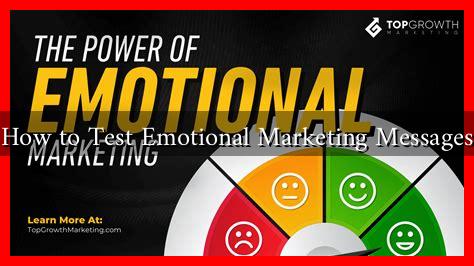-
Table of Contents
How to Test Emotional Marketing Messages
Emotional marketing is a powerful tool that taps into the feelings and sentiments of consumers, creating a deeper connection between brands and their audiences. However, crafting the perfect emotional message is only half the battle; testing its effectiveness is crucial to ensure it resonates with your target market. In this article, we will explore various methods to test emotional marketing messages, supported by examples, case studies, and statistics.
Understanding Emotional Marketing
Emotional marketing leverages feelings such as happiness, sadness, fear, and nostalgia to influence consumer behavior. According to a study by the American Marketing Association, emotional responses to advertisements can significantly impact purchasing decisions, with emotional ads outperforming rational ones by a factor of 3 to 1. This highlights the importance of not only creating emotional messages but also testing them effectively.
Key Methods for Testing Emotional Marketing Messages
To ensure your emotional marketing messages resonate with your audience, consider the following testing methods:
- A/B Testing: This method involves creating two versions of a marketing message—one with an emotional appeal and one without. By measuring engagement metrics such as click-through rates and conversion rates, you can determine which message performs better.
- Focus Groups: Conducting focus group sessions allows you to gather qualitative feedback on your emotional messages. Participants can share their feelings and thoughts, providing insights into how your message is perceived.
- Surveys and Questionnaires: Distributing surveys to your target audience can help gauge their emotional responses to your marketing messages. Questions can range from how the message made them feel to whether it influenced their purchasing intent.
- Social Media Listening: Monitoring social media platforms for mentions of your brand and emotional campaigns can provide real-time feedback. Tools like Hootsuite and Brandwatch can help track sentiment and engagement.
- Neuromarketing Techniques: Advanced methods such as eye-tracking and facial coding can provide insights into how consumers emotionally respond to your marketing messages on a neurological level.
Case Studies: Successful Emotional Marketing Campaigns
Several brands have successfully tested and implemented emotional marketing messages, leading to increased engagement and sales. Here are a few notable examples:
- Always – #LikeAGirl: This campaign aimed to empower young girls and challenge gender stereotypes. By testing various emotional messages, Always found that the message resonated deeply with their audience, leading to a 76% increase in brand favorability.
- Google – Year in Search: Each year, Google releases a video summarizing the most searched topics, often evoking nostalgia and reflection. The emotional resonance of these videos has led to millions of views and shares, reinforcing Google’s brand identity.
- John Lewis – Christmas Advert: Known for its heartwarming Christmas ads, John Lewis invests heavily in testing emotional narratives. Their ads often evoke feelings of nostalgia and generosity, resulting in increased foot traffic and sales during the holiday season.
Measuring the Impact of Emotional Marketing
Once you have tested your emotional marketing messages, it’s essential to measure their impact. Key performance indicators (KPIs) to consider include:
- Engagement Rates: Monitor likes, shares, comments, and overall engagement on social media platforms.
- Conversion Rates: Track how many users take the desired action after interacting with your emotional message.
- Brand Sentiment: Analyze consumer sentiment through social listening tools to understand how your message is perceived.
- Return on Investment (ROI): Calculate the financial return generated from your emotional marketing campaigns compared to the costs incurred.
Conclusion
Testing emotional marketing messages is essential for creating campaigns that resonate with consumers and drive engagement. By employing methods such as A/B testing, focus groups, and neuromarketing techniques, brands can refine their emotional narratives to better connect with their audience. Successful case studies from brands like Always and Google demonstrate the power of emotional marketing when tested effectively. Ultimately, measuring the impact of these messages through engagement rates, conversion rates, and brand sentiment will help marketers understand the effectiveness of their emotional strategies. By prioritizing testing and measurement, brands can harness the full potential of emotional marketing to foster deeper connections with their consumers.

